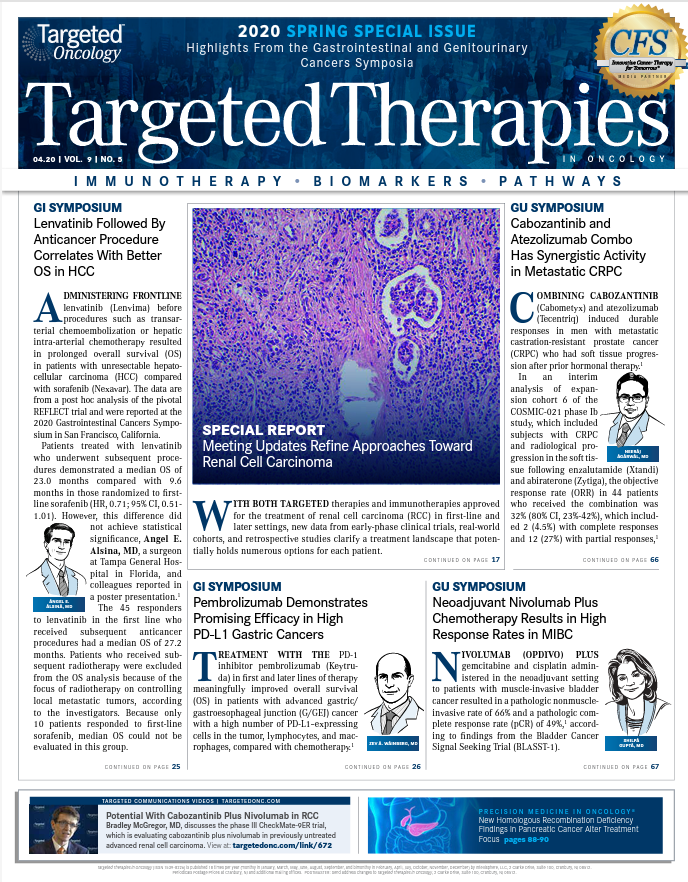Nintedanib Shows Significant Benefit in PFS, OS in Muscle-Invasive Bladder Cancer
Investigators found no difference in the primary end point of pathologic complete response between the 2 arms of a trial evaluating gemcitabine and cisplatin plus either nintedanib or placebo in muscle-invasive bladder cancer; however; secondary end points of progression-free survival and overall survival demonstrated significant benefit in patients who got nintedanib.

Investigators found no difference in the primary end point of pathologic complete response (pCR) between the 2 arms of a trial evaluating gemcitabine and cisplatin plus either nintedanib (Ofev) or placebo in muscle-invasive bladder cancer; however; secondary end points of progression-free survival (PFS) and overall survival (OS) demonstrated significant benefit in patients who got nintedanib.1Results were presented by Syed Hussain, MD, MBBS, MSc, professor and consultant in medical oncology in the Department of Oncology and Metabolism at The University of Sheffield in the United Kingdom, during the 2020 Genitourinary Cancers Symposium in San Francisco, California.
The phase III neoadjuvant trial randomized 120 patients 1:1 to receive standard-of-care chemotherapy with nintedanib (n = 57) or placebo (n = 63). The UK trial allowed carefully selected patients to undergo cystectomy or organ preservation treatment after discussing the option with their treating physician. Follow-up scans were conducted 3 months after radical treatment and at 6 and 12 months thereafter.
After 3 cycles of neoadjuvant chemotherapy, pCR was assessed through a mandatory tumor biopsy. The pCR for patients in the nintedanib arm was 51% (21 of 41) compared with 37% in the intention-to-treat (ITT) population (21 of 57). In the placebo arm, the pCR was 44% (20 of 45) compared with 32% in the ITT population (20 of 63). The OR was 1.41 (95% CI, 0.84-2.06; TABLE 1).1
Regarding complete responses (CRs), patients in the nintedanib arm had an overall rate of 40% (22 of 54) versus 38% in the ITT population (22 of 57). Patients in the placebo arm had an overall CR rate of 45% (25 of 55) versus 39% in the ITT population (25 of 63). The OR for the overall CR was 0.90 (95% CI, 0.60-1.35; P = .893; TABLE 2).
The secondary end point of PFS showed a rate of 89% for the nintedanib arm compared with 74% for the placebo arm at 12 months. At 24 months, the PFS for the nintedanib arm was 82% compared with 61% for the placebo arm (HR, 0.468; P = .013).
“In terms of the secondary outcome of overall survival, the 12-month overall survival [rate] was 83% versus [96% in] the experimental arm,” Hussain said. “The 24-month overall survival with the standard-of-care chemotherapy plus placebo was 69%, whereas the standard-of-care chemotherapy plus nintedanib was 89%, with a hazard ratio of 0.379 and a clinically and statistically significant P value of .018.”
To be eligible for the trial, patients had to have histologically proven muscle-invasive transitional cell carcinoma of the bladder and localized muscle-invasive carcinoma of stage T2 to T4 N0M0. Patients were required to have a glomerular filtration rate (GFR) of ˃60 mL/min that was measured by ethylenediaminetetraacetic acid clearance, 24-hour urine collection, or the Cockcroft-Gault formula. Investigators reported that patients with a GFR of 40 to 60 mL/min were enrolled into a safety substudy consisting of a 3 + 3 design. These 9 patients received 150 mg of nintedanib/placebo twice a day, as well as 35 mg/m2of cisplatin and 1000 mg/m2of gemcitabine on days 1 and 8.
The median age of the patients enrolled was 69 years, and about three-quarters were men. Ninety-eight patients (81.7%) had an ECOG performance status of 0, and 22 (18.3%) had an ECOG performance status of 1. Of the 73 patients (60.8%) who were tumor stage T2, 35 (61.4%) received nintedanib and 38 (60.3%) received placebo. Of the 25 patients (20.8%) who were T3b, 13 (22.8%) received nintedanib and 12 (19.0%) received placebo. Other treated patients included those with tumor stage T3a, T4, and Tx.
Patients in the treatment arm received 200 mg of nintedanib twice daily for 12 continuous weeks, 1000 mg/m2of gemcitabine on days 1 and 8, and NA 70 mg/m2of cisplatin on day 1, which was split over 2 doses on days 1 and 8 for patients with a GFR <60 mL/min.
Regarding toxicity, thromboembolic events were relatively similar between the 2 arms; however, patients in the nintedanib arm experienced more neutropenia and hypertension than patients in the placebo arm.
“In terms of the neutropenic effects, increased febrile neutropenia did not lead to increased hospitalization visits,” Hussain said. “Further, in the placebo arm, there were 4 episodes of febrile neutropenia. In the nintedanib [arm], there were 2 episodes of febrile neutropenia.”
For grade 3 adverse events (AEs) or higher, thromboembolic events were most commonly reported, with a total of 29 (16 in the nintedanib arm and 13 in the placebo arm). Decreased neutrophil counts were observed in 7 patients (6 in the nintedanib arm and 1 in the placebo arm), and 6 instances of febrile neutropenia occurred (2 in the nintedanib arm and 4 in the placebo arm).
“There were 2 cases of myocardial infarction, which were observed in the placebo arm,” Hussain said.
Among AEs not reported as severe, Hussain noted an increase in hypertension among patients treated with nintedanib; however, he attributed this to a class effect. “But it did not lead to increased [discontinuation] of nintedanib treatment or the protocol chemotherapy with gemcitabine and cisplatin,” he said.
The investigators collected samples of blood, urine, and tissue, which Hussain said he hopes will help identify potential RET biomarkers or predictive markers in future studies. Nintedanib was previously approved by the FDA to slow the rate of decline in pulmonary function in adults with interstitial lung disease associated with systemic sclerosis or scleroderma.2
“Nintedanib at a dose of 150 mg twice a day can be safely delivered with split-dose cisplatin and a standard gemcitabine chemotherapy in patients with GFR between 40 and 60 mL/min,” he concluded.
References:
- Hussain SA, Lester JF, Jackson R, et al. Phase II placebo controlled randomised trial of nintedanib with gemcitabine and cisplatin in locally advanced muscle invasive bladder cancer. J Clin Oncol. 2020;38(suppl 6;abstr 438). doi: 10.1200/JCO.2020.38.6_suppl.438.
- FDA approves first treatment for patients with rare type of lung disease [news release]. Rockville, MD: FDA; September 6, 2019. bit.ly/2QljHTS. Accessed March 16, 2020.

Gasparetto Explains Rationale for Quadruplet Front Line in Transplant-Ineligible Myeloma
February 22nd 2025In a Community Case Forum in partnership with the North Carolina Oncology Association, Cristina Gasparetto, MD, discussed the CEPHEUS, IMROZ, and BENEFIT trials of treatment for transplant-ineligible newly diagnosed multiple myeloma.
Read More
Key Trials From ASH 2024 Impact Treatment for Plasma Cell Disorders Going Forward
February 20th 2025Peers & Perspectives in Oncology editorial board member Marc J. Braunstein, MD, PhD, FACP, discussed the significant advancements in multiple myeloma treatment at the 2024 ASH Annual Meeting and Exposition.
Read More